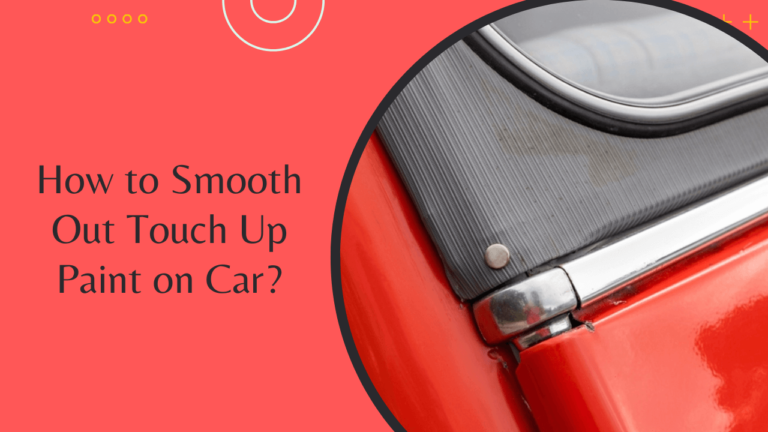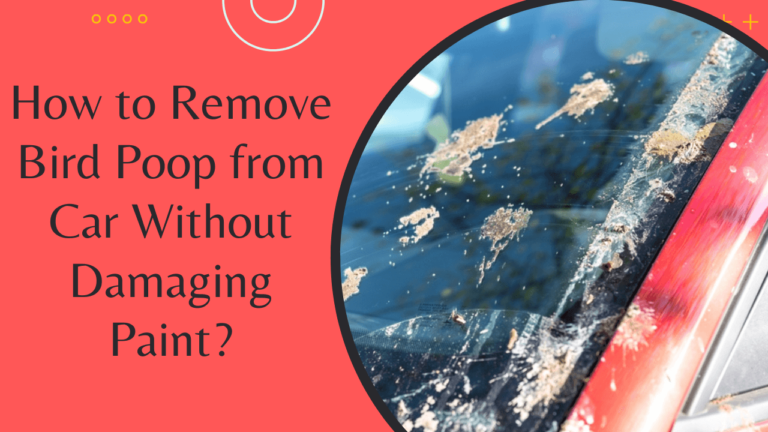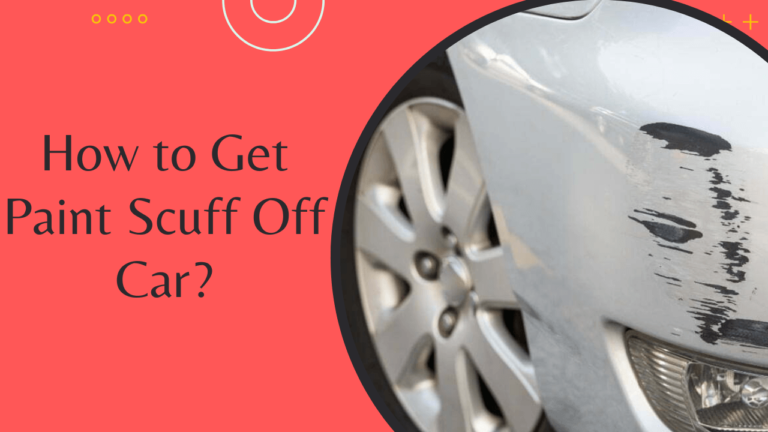How to Fix Paint Chips on Car
Do you notice those paint-missing patches on your car? Paint chips are prevalent. Small rocks or particles strike your automobile while traveling, peeling the paint. No worries—fixing them is simpler than you think!
To start, clean the area with some soap and water to make sure it’s nice and tidy. Then, use alcohol or white spirit to wipe it down. Next, gently sand down any raised edges around the chip. After that, apply a primer or base coat, followed by the paint itself in thin layers. Once it’s dry, sand it gently again to make sure it’s smooth. Stick with us until the end to learn more about fixing those pesky paint chips on your car!
Why Does Paint Chip on Car?
There are many reasons why this happens:
1. Road Debris

Small rocks, gravel, and other debris kicked up by tires can hit the surface of your car while driving. These impacts can chip away at the paint, leaving behind those noticeable spots.
2. Weather Exposure
Over time, excessive heat, cold, rain, and snow may degrade automobile paint. This increases chipping and peeling.

3. Road Salt
Road salt melts ice and snow in winter. However, salt may erode automotive paint, flaking and rusting it.
4. Poor Maintenance
Forgetting to wash and wax your automobile may hasten paint deterioration. Surface contamination from dirt, filth, and other pollutants makes paint chips easily.
5. Impact Damage
Even mild impacts may harm paint. Rust and chipping may occur when scratches, dents, and dings reveal the metal.

6. Age and Wear
Your car’s paint degrades naturally with age. In regions with regular friction or contact, it may become brittle and chippable.
How to Identify Paint Chips on Car?
Identification of automotive paint chipping is essential for prompt repair and maintenance. How to spot them:
- In excellent illumination, inspect the outside of your automobile. Look for minor paint chips or missing patches.
- Gently touch the car’s surface. Paint chips may feel rough or uneven compared to the surrounding paint.
- Inspect the affected areas for any noticeable differences in color. Paint chips often expose the primer or bare metal underneath, creating a contrasting hue.
- Keep an eye out for signs of rust around paint chips. Bare metal exposed to moisture and air develops rust, requiring rapid treatment.
- Paint chips are most prevalent on the front bumper, hood, and side panels, where road debris and collisions occur.
How to Fix Paint Chips on Car? [Step-by-Step]

To fix it all, first you need a few things before you begin.
What You’ll Need for DIY Paint Chip Repair
A few essentials are needed to start a DIY vehicle paint chip restoration job. First, buy auto body touch-up paint for your car’s make, model, and year from an auto parts shop. Refer to the provided booklet or consult your vehicle identification plate to locate the exact color number required for a perfect match.
If you can’t find the correct color at the store, consider checking with your dealer, who may carry the specific colors for your vehicle. Additionally, purchase a small can of auto primer to prepare the surface for painting. Remember to avoid conducting the repair in direct sunlight or when temperatures drop below 10°C for optimal results.
Key Elements Needed:
- Auto body touch-up paint
- Auto primer
- Denatured alcohol
- Polishing compound
These essential supplies, combined with careful application techniques, will help you effectively address those bothersome paint chips on your car, restoring its appearance and protecting it from further damage.
Steps to Follow:
Car paint chip repair needs time and the correct instruments. Simple step-by-step instructions:
- Wash the area with soap and water, then wash it down with denatured alcohol to remove oil and clean the surface. Let it dry completely.
- Use very fine sandpaper or a cutting compound to gently sand down any raised edges around the chip. Be careful not to damage the surrounding clearcoat.
- Apply a primer or base coat using a fine brush or paint pen from your auto body touch-up paint kit. Let it dry thoroughly.
- Apply the paint in thin layers, mimicking the original application. Don’t paint outside the damaged area; let each coat dry before adding the next.
- Use extremely fine sandpaper wrapped around a pencil to carefully level the paint once it dries.
- Finally, finish the repair with a topcoat or lacquer and let dry.
This easy process with the right materials may cure paint chipping on your automobile and restore its beauty.
How Much Does It Cost to Fix Paint Chips on Car?
Here’s a breakdown of average auto paint repair costs based on the type of repair:
| Paint Repair Type | Average Cost Range | Description |
| Touch-up (small area) | $50 – $150 | Repairing small paint chips or scratches in a localized area. |
| Touch-up (Medium Area) | $150 – $300 | Addressing paint damage in a slightly larger area than a small touch-up. |
| Paint Chips | $100 – $400 | Fixing multiple paint chips scattered across the car’s surface. |
| Minor Scratch | $200 – $600 | Repairing minor scratches that are longer or deeper than chips. |
| Scrapes | $300 – $800 | Removing paint damage caused by scrapes against surfaces. |
| Panel Painting (per panel) | $200 – $800 | Repainting individual panels of the car, such as doors or fenders. |
| Bumper Repair/Repaint | $300 – $800 | Repairing and repainting damaged bumpers. |
| Door Repaint | $400 – $1,000 | Completely repainting a single door due to extensive damage. |
| Hood Repaint | $400 – $1,200 | Repainting the hood to address significant paint damage. |
| Fender Repaint | $300 – $900 | Repainting a fender due to paint chips or scratches. |
| Roof Repaint | $500 – $1,500 | Repainting the roof area to fix extensive paint damage. |
| Whole Car Respray (Basic) | $1,000 – $3,000 | Completely repainting the entire car with a basic paint job. |
| Whole Car Respray (Advanced) | $3,000 – $5,000 | Completely repainting the entire car with an advanced paint job, including custom finishes or colors. |
These costs may vary depending on factors such as the extent of damage, type of paint used, and labor rates in your area.
The Best Ways to Protect Your Car from Future Paint Chips
There are six excellent strategies to prevent paint chipping on your car:
- Transparent bras protect the bumper, hood, and side mirrors.
- Wash your car often to remove dirt, debris, and paint-damaging chemicals. Wax adds chip and scratch prevention.
- Keep a safe distance from other automobiles, particularly on gravel roads or highways, to avoid debris touching your car’s paint.
- Drive carefully, particularly behind vehicles or on uneven roads with debris.
- Park away from high-traffic areas, trees, and construction zones to avoid pebbles, branches, and trash.
- Keep dirt off your car’s paint with mud flaps or splash shields.
- Protect your car’s paint against chipping, UV rays, and environmental damage with a ceramic coating. Ceramic coatings endure and may preserve automotive paint.
Common Mistakes to Avoid When Fixing Pant Chips
Successful automotive paint chip repair requires avoiding common errors. Remember these crucial elements:
Proper Cleaning is Crucial
Clean the damaged area before repairing. Dirt, debris, and pollutants must be removed to avoid repair interference and additional damage.
Don’t Skip the Primer
Priming is essential to repair. It smooths the surface for painting and strengthens the paint-bodywork connection, lowering the chance of peeling or flaking.
Apply Paint Carefully
Avoid using too much paint when filling in the chip. Applying several thin coats is preferable to one thick coat to prevent runs or drips that can be challenging to remove without causing additional damage.
Smooth Sanding is Key
Sand brush strokes and edges after applying touch-up paint. To prevent UV and environmental damage, this procedure is necessary before polishing and waxing.
Don’t Forget the Wax
After fixing the damage, wax it to protect it from UV rays, rain, and other factors. This prevents chipping and preserves the restoration.
Final Words
Fixing automotive paint chipping restores its beauty and preserves its value and lifespan. When cleaning and applying properly, you may get professional-quality results for a fraction of the expense. Be patient and meticulous in this attempt.
With this knowledge and regular care, you can confidently fix paint chips and keep your automobile a sparkling light of pride for years to come.
Frequently Asked Questions
Can car chips be repaired?
Touch-up paint and right method may fill in automobile chips and restore their look.
How do you touch up a small paint chip on a car?
Clean the automobile, apply primer if required, gently fill in a tiny paint chip with touch-up paint, and let it dry before adding a clear coat for protection.
How do you fix chipping paint?
Clean the area, smooth any rough edges, apply primer, fill the chip with touch-up paint, let it dry, then sand and polish to integrate it with the surrounding paint.



